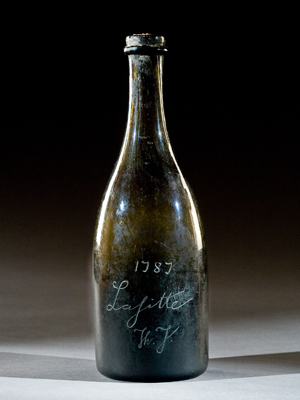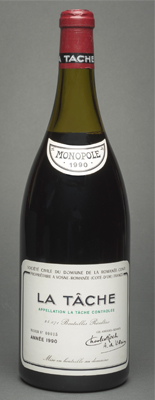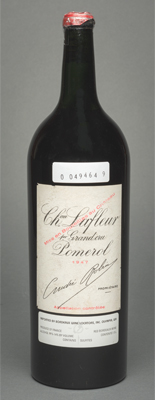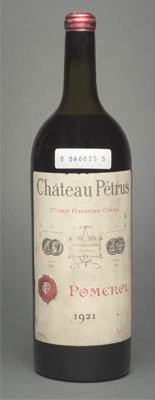Thomas Jefferson’s Wine?
The recent extraordinary inflation in the prices of rare wine has led to an explosion of counterfeits in the wine trade. Evaluating fine wine is a difficult task. Buyers do not always have the requisite palate to properly judge, and even experts can be fooled. The vast majority of fake wines are happily enjoyed nonetheless.
In 1985 a bottle of wine was sold at Christie’s in London that purportedly had been purchased in Paris by Thomas Jefferson in the late 1780s, when he was serving as America’s minister to France. Attracted to the historic significance of the wine, collectors bid at auction to own a link to the third President of the United States. Collector William I. (Bill) Koch later purchased four bottles from the same consignor. Becoming suspicious after several experts questioned the authenticity of the wine, Koch traced all the bottles back to a German wine collector and connoisseur named Hardy Rodenstock.
Provenance
According to Rodenstock, a number of bottles (he never specified how many) had been found behind a brick wall in the cellar of a building in the Marais section of Paris. Seeking corroboration of the provenance, Koch’s staff approached the Thomas Jefferson Foundation at Monticello. The country’s leading authority on Jefferson’s records determined that the bottles matched neither Jefferson’s records wine purchases in Paris nor the artifacts uncovered on the grounds of the Monticello estate.
Connoisseurship
Corning Museum, which specializes in the study and display of all kinds of glass, recommended that Koch consult with a former employee―a master glass engraver who had retired from the museum after thirty years of service. That engraver concluded that an electric engraving drill had been used on the questionable bottle instead of a copper wheel, which someone in the 18th century would have used.
Scientific Analysis
The wine in some of the bottles purported to have belonged to Thomas Jefferson was subjected to Carbon-14 dating by different scientists, with conflicting results. Koch commissioned a French nuclear physicist to test his bottles using low-frequency gamma rays, which detect the presence of the radioactive isotope cesium-137. Cesium-137 is not a naturally occurring isotope. It only appears as a result of nuclear fallout. A wine that was bottled before the advent of atmospheric nuclear testing should contain no cesium-137. In fact, no cesium-137 was detected in the Koch bottles; however, because the isotope has a half-life of only thirty years, this merely confirms that the wine dates to before 1943.
This is one of the bottles sold by Hardy Rodenstock, who claimed that it had been owned by Thomas Jefferson. Jefferson lived in Paris between 1784 and 1798 and is known to have enjoyed drinking fine wines. Rodenstock created a false provenance for this wine, claiming that it had been found hidden behind a brick wall in the cellar of a house in Paris. Jefferson never lived near the Marais district when he was in Paris.
The bottle has no label and no secure provenance. Do you think it looks like a fake?
This photographic enlargement enables us to see that the letters and numbers on the bottle were engraved by a modern dentist’s tool or a Dremel drill. The thickness of the engraved lines is uniform. Lines engraved by a copper wheel, which would have been used in the 18th century, vary in thickness.
Verdict
In this case, it was connoisseurship of the engraving on the bottle that determined that the purported Jefferson wine was fake. Debate over the authenticity of the bottles ended when two German artisans confessed to having engraved the names and dates for Rodenstock. In August 2006, Koch filed a suit against Hardy Rodenstock (aka Meinhard Goerke), accusing him of fraud. Koch won a default judgment against the defendant, who refused to participate in the case and currently owes Koch several million dollars, with interest compounding.
Faking the Labels
Because the price of a great vintage of fine wine often dwarfs the price of an indifferent one, many forgers will start with a genuine bottle of cheaper wine and simply replace the label. This was the modus operandi of Rudy Kurniawan (born Zhen Wang Huang), a collector who began buying and selling fine wine in the early 2000s and often hosted tastings of rare wines for other collectors. He was best known for his collection of rare Burgundy. As a result of his prolific production in counterfeits, he is at the center of one of the largest wine fraud scandals in U.S. history. Experts have recently claimed that 80 percent of pre-1980 bottles of Burgundy sold at auction today are fake.
Provenance
Unlike works of art, wine rarely has a history of ownership that goes back to where it was made, but wine producers do keep good records of their production. Because Kurniawan fabricated the counterfeit bottles he sold, what he offered for sale often did not match up with vineyard production records. One particularly astute vineyard owner totaled his consignments and compared them to actual production records, revealing gross inaccuracies.
Connoisseurship
Although it is difficult to authenticate wine itself, it is possible to authenticate labels. With a good scanner and a color printer, labels are easy to replicate. Kurniawan scanned original labels and then printed them out on “antiqued” paper on his color printer. Under magnification, however, the telltale color separation of modern ink-jet printing can clearly be seen.
Analysis
Since Kurniawan was caught red-handed, there was no need for scientific analysis of any of the wine found at his home at the time of his arrest.
With a good scanner and a color printer, labels are easy to replicate. When FBI agents knocked on Kurniawan’s door in 2012, they found hundreds of bottles, corks, stamps, and 18,000 fake wine labels, forming the foundation of the prosecution’s case.
Collection of confiscated vintage wine labels
Courtesy of the Federal Bureau of Investigation, New York Office
Verdict
Rudy Kurniawan is the first person to be tried and convicted in a U.S. federal court for counterfeiting wine. He was sentenced to ten years in prison and ordered to forfeit $20 million in property and pay $28.4 million in restitution to seven of his victims, the only ones who came forward. More than 500 counterfeit bottles of wine he sold were destroyed by U.S. Marshals at a Texas waste disposal site. The total number of fraudulent bottles of wine sold by Kurniawan is unknown, and unfortunately they will continue to circulate in the market for years to come.
Once dubbed “Dr. Conti” by fellow collectors for his love of wines from Domaine de la Romanée-Conti (DRC), infamous wine forger Kurniawan sold this particular bottle (made in his home laboratory) to Bill Koch. Unless you look closely at the label, this impeccable forgery is almost indistinguishable from a genuine 1990 DRC La Tâche. Under high magnification, however, one can clearly see the four-color toner separation, a telltale sign that the label was photocopied.
Deemed fake 1990 Domaine de la Romanée-Conti La Tâche 1.5L
Sold by Rudy Kurniawan; 2005
Courtesy of William I. Koch
Pass the Wine?
Sometimes when collectors discover they have unwittingly purchased counterfeit wines, they try to pass them on to other unsuspecting collectors. Eric Greenberg, a California entrepreneur who had amassed a personal collection of 70,000 bottles of fine wine, sold many of his known fakes to others. Before selling, Greenberg filed a claim with his insurance company, listing hundreds of bottles that were counterfeit and, therefore, worthless. When the claim was rejected, he sued the original seller, Royal Wine Merchants. The case was settled, but Greenberg retained 429 bottles that were listed on the original insurance claim as fake. He resold these, never disclosing that several experts had told him they were counterfeit.
Wine experts from both Sotheby’s and Christie’s were suspicious of the possible presence of fakes, but in 2005 New York auctioneer Zachy’s agreed to sell 17,000 bottles from Greenberg’s collection. Bill Koch spent more than $3.7 million at the sale, focusing on extremely rare wines. He later claimed that twenty-four of the bottles he purchased were fake and sued Greenberg, alleging that Greenberg knew, or should have known, these bottles were counterfeit. A civil jury agreed, finding that Greenberg had knowingly reintroduced counterfeit wines into the marketplace.
Provenance
Investigators discovered that these counterfeit wines also originated from German wine forger Hardy Rodenstock. They were imported into the United States by Royal Wine Merchants in New York, purchased by Eric Greenberg, and resold at auction to Bill Koch.
Connoisseurship
Like all of Rodenstock’s handiwork, these counterfeits were particularly convincing. He made the fake labels the old-fashioned way, using offset printing presses to avoid the pixilated distortion associated with copying machines. The bottles remained unopened, so the contents were not tested.
Scientific Analysis
Several of the bottles were examined by a specialist in the forensic examination of materials. The specialist used microscopy, ultraviolet light, Fourier-transform infrared microspectroscopy (FTIR), and confocal dispersive RAMAN microscopy to examine the labels and found “reasonable scientific certainty” that the papers, printing inks, and adhesives on certain bottles date to decades after the purported date of the bottling of the wines. He also found evidence of artificial aging, including suspicious tearing and staining of the labels to make them appear older than they were.
The former vineyard owner of Château Lafleur told experts investigating the wines that only five magnums were made in 1947 because glass was scarce after the war in France. Surprisingly, Rodenstock imported eighteen magnums of 1947 Lafleur to Royal Wine, including this one. Obviously, the numbers didn’t quite add up.
Styrene, probably in the form of styrene-butadiene latex, was found in the paper label, and polyvinyl acetate was used as the adhesive. Both materials are inconsistent with a purported production date of 1947. Suspicious damage to the edge of the label, together with a dark discoloration, suggests that the label was intentionally altered to appear old.
Deemed fake 1947 Château Lafleur 1.5L
Sold by Hardy Rodenstock; 2004
Courtesy of William I. Koch
This bottle was actually examined at the Château Petrus winery in France and deemed to be counterfeit. The reputation of this château has grown in recent years, and their wine is considered to be exceptional. Its inimitability is due to many factors, including a favorable terroir (natural environment), which is forty meters above sea level and includes a layer of heavy clay soil and an iron subsoil. These are ideal conditions for the Merlot grape.
The presence of Pigment Blue 15 and Pigment Orange 34 in the ink of this label as well as the polyvinyl adhesive are inconsistent with the purported 1921 vintage.
Deemed fake 1921 Château Petrus 1.5L
Sold by Hardy Rodenstock; 2005
Courtesy of Willian I. Koch
Verdict
Several years into his unrelenting and extremely costly campaign to clean up the rare wine business, Bill Koch scored a big victory in 2013, when he was awarded more than $12 million in damages. A New York jury in federal court found in his favor on all counts in his lawsuit against fellow collector Eric Greenberg. Koch has invested millions in investigating fake wines, explaining, “One reason I’m doing this is that there is a code of silence about this wine counterfeit problem. Collectors and individual sellers don’t want anyone to know they have fake wine. They want to dump it on others. I’m the only guy who is blowing the whistle on it.”
Bibliography
Hellman, Peter, and Mitch Frank. “The Crusade against Counterfeits.” Wine Spectator, December 15, 2009.
Wallace, Benjamin. The Billionaire’s Vinegar: The Mystery of the World’s Most Expensive Bottle of Wine. New York: Three Rivers Press, 2009.







